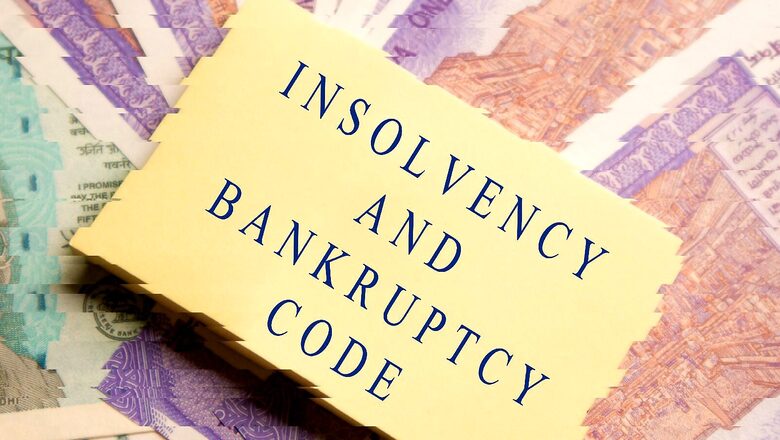
views
Parliament is the temple of democracy and parliamentary procedures the rites by which the will of the people is translated into practice. But the terms and jargon involved in Lok Sabha and Rajya Sabha processes can be difficult to grasp. The News18 series, House Talk, brings you a ready reckoner to make sure that none of it is Greek to you.
Among the bills slated to be listed in the ongoing session of Parliament is The Insolvency and Bankruptcy Code (Amendment) Bill, 2022. In general parlance, insolvency is when a debtor is in no financial shape to pay back all his loans. Bankruptcy is the next step, a legal proceeding initiated where the remaining assets of an individual or business are sold off to partially or fully back creditors.
What is the Insolvency and Bankruptcy Code?
In 2016, the quantum of bad loans or non-performing assets (NPAs) held by state-owned banks was rapidly burgeoning. In just a year, there was a 56.4% surge in NPAs. To put this in perspective, the Indian economy was saddled with Rs 2.2 lakh crore worth of bad loans six years ago. That was equivalent to the combined market capitalization of 33 out of 41 banks listed on the Bombay Stock Exchange.
Naturally, there was a pressing need to constitute a framework to battle such loans and tackle insolvencies and bankruptcies in an effective and time-bound manner. Thus was born the Insolvency and Bankruptcy legislation.
What is The Bill About?
The defaulting debtor or creditor can apply for the corporate insolvency resolution process (CIRP) if the non-payment exceeds Rs 1,00,000.
The creditor’s committee decides on an appropriate recovery plan. This can be a combination of corporate restructuring, mergers, and acquisitions. But if this plan does not meet the approval of 51% of secured creditors within 180 days, the company is pushed into liquidation. However, the National Company Law Tribunal (NCLT) can extend this period for a further 90 days.
In order to condense and streamline the process, the bill also offers a pre-packaged insolvency resolution process (PIRP) for micro, small and medium enterprises (MSMEs). A company with annual turnover of less than Rs 5 crore and less than Rs 1 crore investment in operational equipment is classified as micro enterprise, while that with up to Rs 250 crore turnover and up to Rs 50 crore investment in operational equipment is medium enterprise.
The resolution process can only be initiated by the debtor, who will retain company management during the interim period. But this is subject to having a base plan in place, which has been approved by 66% of creditors. The defaulting amount can range between Rs 1 lakh-Rs 1 crore.
This resolution plan must be sanctioned within 90 days. However, if it fails to go through, the company will slip into liquidation.
Ineffective Legislation?
Instances of liquidation and inadequate recoveries far outweigh the number of companies recused from it, defeating the entire purpose of the bill.
As of March 2022, the Insolvency and Bankruptcy Board of India (IBBI) had 1,852 cases pending before it. That means each case takes a whopping 495 days to conclude. This is when the law stipulates the resolution of all corporate debtors’ insolvency should be wrapped up in under a year (330 days).
More companies are going under the liquidation hammer than being saved. In the six-year period till March 2022, a total of 5,258 companies applied for insolvency. Only 3,406 cases have been closed until now. Just 480 companies managed to escape financial death. But a vast number i.e. 1,609 companies were ordered liquidation.
Reports suggest that recovery rates for creditors too are also low. At 24%, many lenders have been forced to take massive cutbacks on their loans. For instance, those at Videocon Industries had to take a 96% haircut on their loans, with them losing Rs 62,000 crore.
In addition to low creditor recoveries and higher numbers of the company in concern being liquidated, there are other issues that linger. For instance, Indian financial creditors lack experience and expertise in forming a uniform, cohesive policy around loan recoveries.
Additionally, the law also does not ensure that the resolution plan is binding on the applicant. That means an increase in the time and cost involved since the applicant can file counter-petitions.
Another point of contention is that the law doesn’t stipulate or disturb the order of preference in which creditors receive their dues. This causes legal mayhem on the stand as lenders disregard their agreed-upon positions and opt for positions that benefit them the most in financial terms.
The present bill is also woefully insufficient in dealing with cross-border, international liquidations. Per IBBI chairman Ravi Mittal, a model for the same is ready. This is an aspect that will be up for consideration during the Monsoon Session.
The Amendment
The amendment bill seeks to strengthen the Insolvency and Bankruptcy Code by introducing provisions on cross border insolvency. The upcoming amendments aim to press more responsibility on the shoulders of resolution professionals (RP). Not only will they have to ensure complete and full disclosure of their relationship with the applicant, creditors, or other stakeholders, they will also be required to raise invoices under their name.
Read all the Latest News, Breaking News, watch Top Videos and Live TV here.




















Comments
0 comment